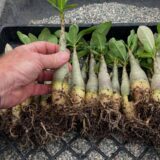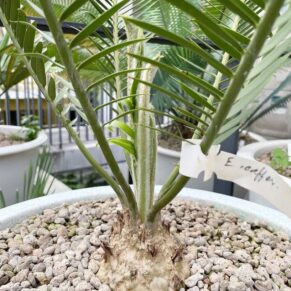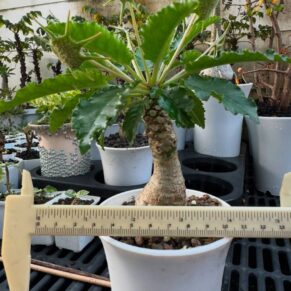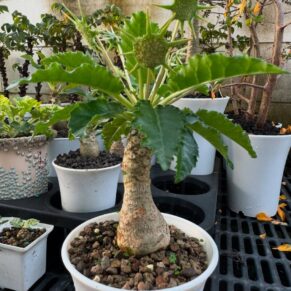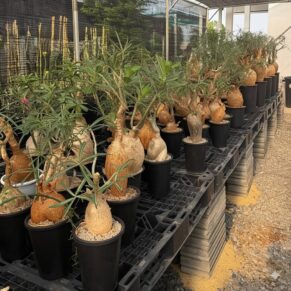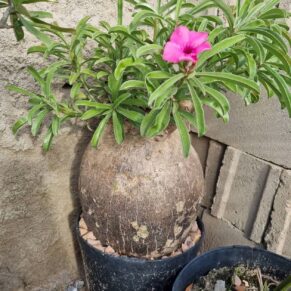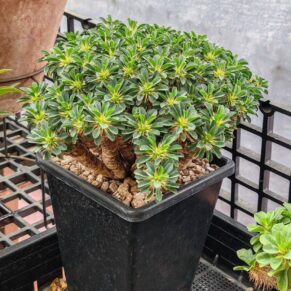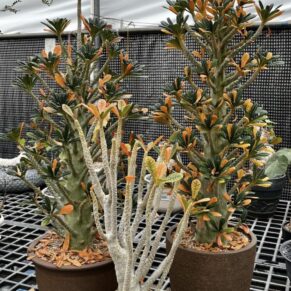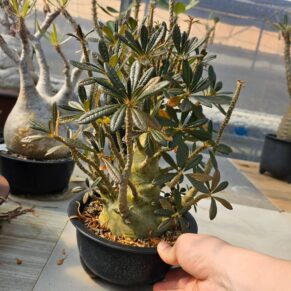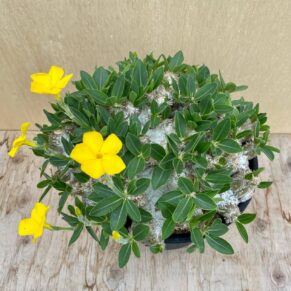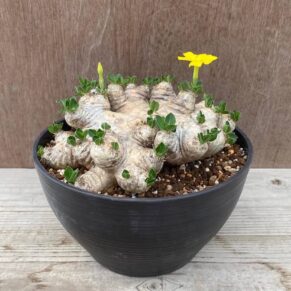- Your cart is empty
- Continue shopping
1. Introduction to Euphorbia bupleurifolia
Euphorbia bupleurifolia is a striking succulent species in the genus Euphorbia, native to South Africa.Visit caudexplants.com if you’re interested in buying some plants .Recognizable by its lobed, broad caudex that resembles a pine cone, this plant often evokes marvel among succulents enthusiasts. Its unique architecture, attractive summer foliage and blooms, and easy cultivation make it a prized addition to succulent collections worldwide.Facebook group
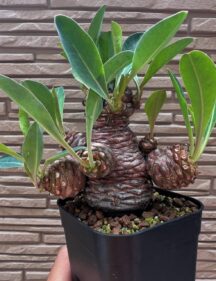
2. Botanical Taxonomy and Nomenclature
Scientific name: Euphorbia bupleurifolia
Authority: Jacquin (1797)
-
Family: Euphorbiaceae
-
Genus: Euphorbia
-
Species: bupleurifolia
Euphorbia bupleurifolia is also known in cultivation history as Monadenium bupleurifolium, though modern taxonomy places it firmly in Euphorbia. Common names include Pine Cone Euphorbia, Boesenootjie (Afrikaans), or Ihlambamcnste in Zulu.Visit caudexplants.com if you’re interested in buying some plants
The specific epithet “bupleurifolia” literally means “with leaves like Bupleurum” – referencing similarity to leaves of the genus Bupleurum. This link is part of its taxonomic and morphological story.
3. Native Habitat and Distribution
3.1 Geographic range
Euphorbia bupleurifolia originates from South Africa’s Eastern Cape and KwaZulu‑Natal provinces, inhabiting granite koppies, cracking rock outcrops, and rocky slopes near the coast. It thrives in semi‑arid, well‑drained habitats with winter rainfall. The species shows microdistribution often restricted to specific hills or ridges.Visit caudexplants.com if you’re interested in buying some plants
3.2 Climate and ecological interactions
-
Climate zone: Mild, semi‑arid to mesic, winter‑rainfall regions
-
Soil: Rapid‑draining rocky granitic soils, often shallow layer over granite bedrock
-
Seasonal cycle: Growth in cool wetter winters, dormancy in hot dry summers
-
Companion flora: Often co‑occurs with other South African succulent Euphorbias, mesembs, small geophytes
In its native range, it survives heat, intense sun, occasional frost (down to just below freezing) and prolonged drought. Wild populations often show cryptic coloration matching local rock, protecting against herbivory.Visit caudexplants.com if you’re interested in buying some plants
4. Morphology and Description
4.1 Caudex (stem base)
The most iconic feature of Euphorbia bupleurifolia is its thickened caudiciform stem (caudex), swollen and globose to compressed, often flanged or ridged — the “pine cone” appearance. Dimensions vary:
-
Diameter: typically 5–20 cm in mature plants
-
Height: 5–15 cm above soil; often broader than tall
-
Coloration: ranges from pale grey‑green, olive, to mottled reddish or brown tones
-
Surface texture: rough, segmented ridges; sometimes patchy corking in older individuals
4.2 Leaves
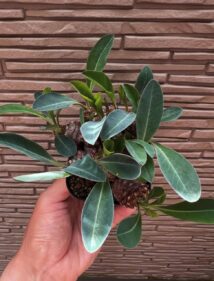
Each growing season (winter/spring), Euphorbia bupleurifolia produces pseudostems of slender petioles bearing leaves:
-
Shape: elliptic‑spatulate, 3–8 cm long, 1–3 cm wide
-
Color: light to mid‑green, sometimes slightly glaucous
-
Veins: subtle, narrow
-
Arrangement: rosettes of 6–15 leaves atop short stems above caudex
-
Duration: deciduous — leaves are shed in dry summer dormancy
4.3 Flowers (cyathia)
Euphorbia bupleurifolia blooms in late winter to early spring (around August–September in Southern Hemisphere). The inflorescences are typical of Euphorbia:
-
Cyathia: small cup‑shaped structures bearing staminate and pistillate flowers
-
Color: pale yellow-green to creamy white
-
Peduncles: slender, erect to spreading, 3–10 cm long
-
Bloom habit: numerous small umbels above the leafy rosette
-
Fragrance: mild, sometimes barely perceptible
Following pollination, seed capsules develop and split explosively, dispersing seeds several centimeters.
4.4 Seasonal development cycle
-
Winter (growth phase): Leaves unfurl, stems elongate, photosynthesizing actively.
-
Spring (blooming): Cyathia appear; after flowering, seeds release.
-
Early Summer: Leaves yellow and drop; caudex enters dormancy.
-
Summer: Minimal water; caudex rests; new root growth suppressed.
-
Autumn: Light rains induce new root flush, preparing for next winter’s growth.
5. Cultivation and Care
5.1 Soil and potting mix
Euphorbia bupleurifolia requires excellent drainage. Recommended potting mixture:
-
1 part mineral coarse grit (e.g. pumice, lava rock)
-
1 part coarse river sand or calcined clay
-
1 part high-quality cactus‑succulent mix (or fine perlite + composted bark)
Avoid peat‑based mixes or heavy clay soils. Small electric drill‑holes in containers can improve drainage.
5.2 Pot and container choice
-
Material: Unglazed terracotta or porous materials to allow airflow
-
Size: Slightly larger than the caudex diameter; shallow containers work well
-
Depth: shallower pots reduce overwatering risk
-
Lift: Caudex partially above soil line mimics natural exposure
5.3 Light
-
Indoors: Bright, filtered sunlight; south/east‑facing windows optimal
-
Outdoors: Morning sun, afternoon shade in hot climates; dappled light under shade cloth
-
Tolerance: Can withstand strong sun, but leaf burn may occur if suddenly exposed
5.4 Temperature
-
Growth season (winter to spring): Ideal ~15–25 °C
-
Dormancy (summer): Stops growth; tolerates 30‑35 °C, dry conditions
-
Minimum: Short exposure to ~ –1 to –2 °C may be tolerated if bone‑dry; risk of damage if damp
-
Maximum: ~40 °C may be tolerated if airflow and dryness maintained
5.5 Watering
Principles of Wasser:
-
Winter–spring (active): Water moderately; permit light watering once substrate dry to 2–3 cm depth
-
Immediately after flowering: Reduce to minimal to simulate dry dormancy
-
Summer (rest): Withhold water completely or very sparingly (e.g. once per 6–8 weeks, only if caudex visibly shriveling)
-
Autumn (transition): Resume light watering as temperatures fall and growth resumes
Common mistakes include overwatering during dormancy leading to caudex rot, or watering dry plants under cold conditions.
5.6 Fertilizer
Use a balanced, weak cactus fertilizer during active growth (e.g. low‑nitrogen 5‑10‑10) once monthly. Avoid fertilizing when dormant.
5.7 Repotting
Repot every 2–3 years:
-
Preferably early autumn, before growth resumes
-
Refresh potting medium, check roots for health; trim damaged or rotting tissue
-
Allow plant to rest for a week before watering after repotting
6. Propagation Methods
6.1 By seed
-
Collect ripe seeds: when the three parted capsules begin to dry and crack
-
Sow in trays with fast‑draining mix; cover lightly with grit
-
Germination conditions: warm (~20–25 °C), bright, lightly moist surface
-
Expect germination within 1–4 weeks
-
Seedlings require careful watering; lift gradually into adult mix over months
-
Advantage: maintain genetic diversity, variation in leaf shape, caudex form
6.2 By cuttings
Although less common:
-
Leaf‑stem cuttings can be taken: allow cut surface to callus for several days
-
Place in well‑draining mix; bottom‑warmth encourages rooting
-
Water sparingly until roots form; root hormones may help
-
Takes longer to develop significant caudex; often used only for clones
6.3 Division
Mature specimens occasionally produce offshoots (pups) at the caudex base:
-
Carefully separate in autumn
-
Re‑plant each pup individually and treat like small caudiciform young
7. Pests, Disorders, and Disease Management
7.1 Common pests
-
Mealybugs (especially root mealy): inspect roots during repotting; treat with systemic insecticide or isopropyl alcohol on cotton swabs
-
Scale insects: occasional on leaves or leaf scars; also treat with alcohol or horticultural oil
-
Spider mites: rare indoors; manage humidity and spray mild soapy water if observe.Visit caudexplants.com if you’re interested in buying some plants
7.2 Diseases
-
Root rot: primary issue caused by overwatering or poorly draining soil
-
Symptom: soft, mushy caudex, yellow‑black discoloration
-
Prevention: grow dry in summer, use coarse mix, avoid watering cold caudex
7.3 Physiological disorders
-
Sun scorch: white or brown patches from sudden intense sun
-
Frost damage: sunken soft spots if frozen while moist; necrosis in caudex tissue
-
Nutrient imbalance: excessive nitrogen can cause long weak stems; leaf burn from fertilizer salts
8. Landscaping and Decorative Uses
8.1 Container displays
Euphorbia bupleurifolia is ideal as a specimen plant in succulent & caudiciform displays:
-
Display options: bonsai‑style shallow trays, specialist caudiciform pots, succulent dish gardens
-
Paired with mineral substrates (lava, gravel) to showcase caudex
Visit caudexplants.com if you’re interested in buying some plants
Grouped with other low‑growing succulents like Lithops, Ceropegia,.
8.2 In conservatories and desert gardens
-
Used as architectural focus points in arid gardens
-
Tolerates xeriscaping, with minimal soil cover—rocks mimic natural habitat
-
Works well in courtyard planters or under shade structures
8.3 Edging or feature in plant exhibitions
-
Highly collectible: often exhibited in caudiciform shows
-
Judged on symmetry, unique caudex ridging, leaf form and overall health
9. Cultural, Horticultural and Conservation Notes
9.1 Collectibility
Euphorbia bupleurifolia has become a cult favorite in succulent collectors’ community:
-
Rarity of specimens with unusual caudex shape commands premium prices
-
Seed-grown plants from niche exchanges prized for genetic variability
9.2 Conservation status
-
Not listed as threatened on IUCN global list (some local vulnerability suspected due to habitat disturbance)
-
Wild populations face pressure from quarrying, over‑collecting, agricultural expansion
-
Encouraging ex‑situ cultivation and diaspora propagation reduces wild harvesting pressure
9.3 Legality and trade
-
Euphorbia bupleurifolia is CITES Appendix II—international trade requires permitting
-
Most nursery trade is from cultivated sources, not wild harvest
-
Buyers should ensure compliance with local and international laws

Euphorbia bupleurifolia

